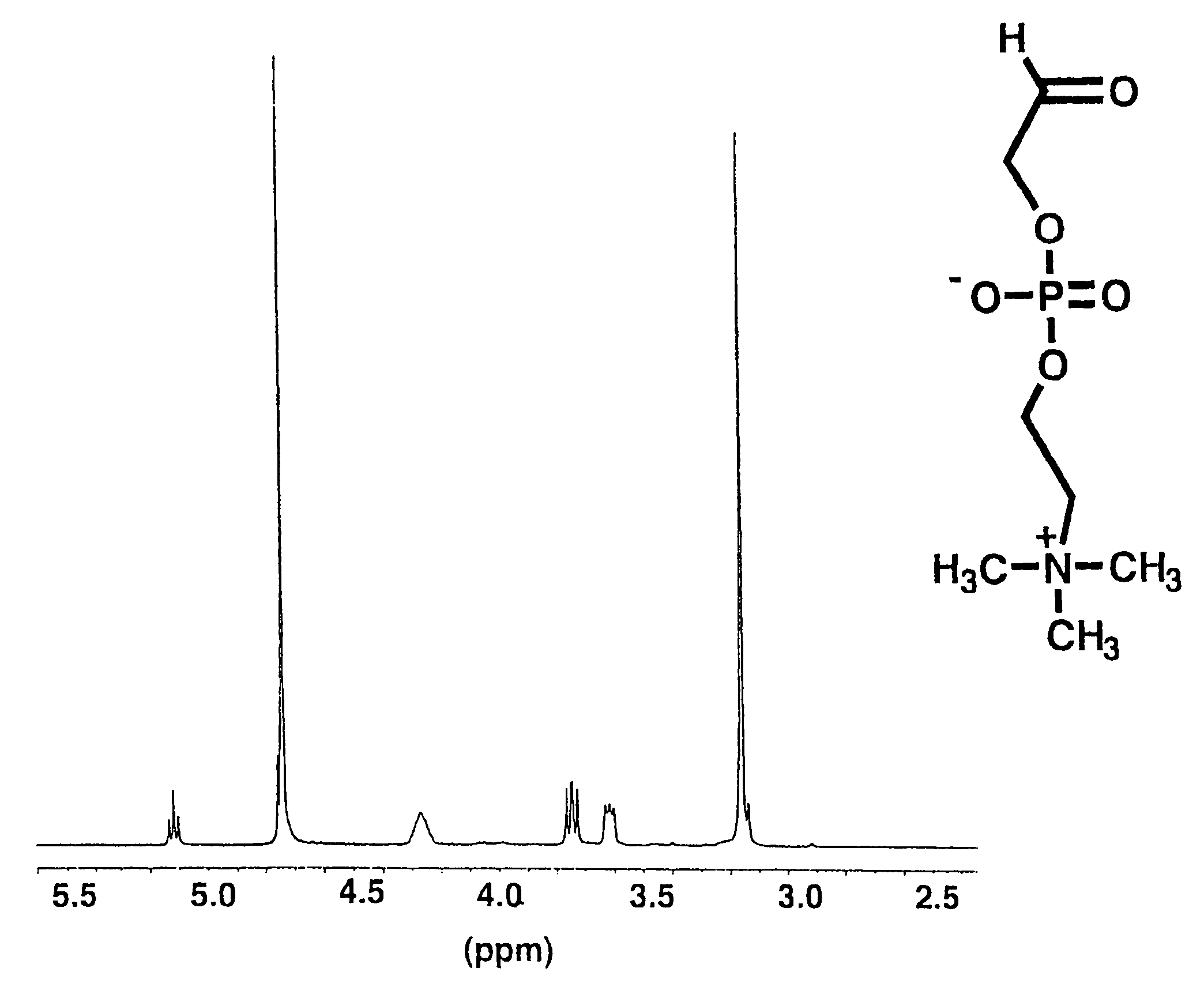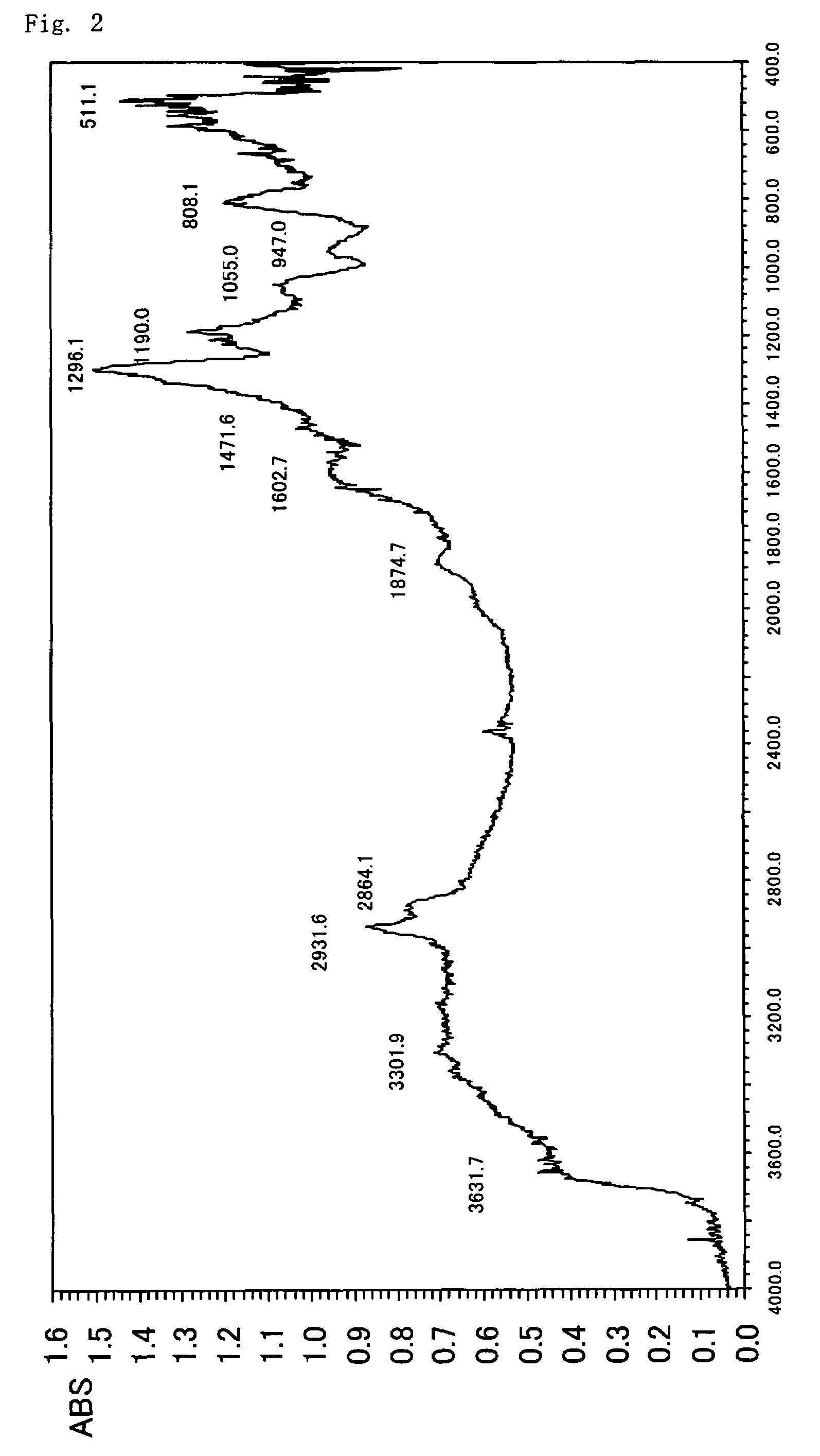Method of modifying surface of material
a surface modification and material technology, applied in the field of surface modification, to achieve the effect of preventing protein adsorption, high reliability analysis, and high separation
- Summary
- Abstract
- Description
- Claims
- Application Information
AI Technical Summary
Benefits of technology
Problems solved by technology
Method used
Image
Examples
synthesis example 1
An Aldehyde Derivative Containing a Phosphorylcholine Group
[0324]L-α-glycerophosphorylcholine (450 mg) is dissolved in 15 ml of distilled water and cooled in an ice water bath. Sodium periodate (750 mg) is added and two hours of stirring is carried out. Furthermore, ethylene glycol (150 mg) is added and overnight stirring is carried out. The reaction solution is vacuum-concentrated and vacuum-dried and the target substance is extracted with methanol.
The structural formula and the NMR spectrum are shown in FIG. 1.
[1: Invention Defined by Surface Modification]
example 1-1
Silica Gel Modified with Phosphorylcholine Groups
[0325]10 g of silica gel having an average size of 5 micrometers (pore size 80 angstroms) is dispersed in water (15 ml) / 2-propanol (15 ml), to which 3-aminopropylmethoxysilane (5 g) is added, and the temperature is raised to 100° C. and the reaction is carried out for 6 hours. After cooling down to room temperature, the silica gel is filtered, rinsed, and dried under a reduced pressure to obtain silica to which amino groups have been introduced. A transmission type FT-IR spectrum of this silica is shown in FIG. 2.
[0326]This silica gel is dispersed in 100 ml of methanol and mixed with 10 g of the compound obtained in Synthetic example 1, followed by stirring for 6 hours at room temperature. This mixed solution is then cooled in an ice bath, 3 g of sodium cyanotrihydroborate is added to it, and stirring is carried out overnight at room temperature; the silica gel is then filtered, rinsed with methanol, and dried under a reduced pressure...
example 1-2
N-isopropylacrylamide / Acrylic Acid Copolymer Particles Modified with Phosphorylcholine Groups
[0332]Sodium dodecylsulfate (20 mg), N-isopropylacrylamide (2.7 g), acrylic acid (172 mg), and methylenebisacrylamide (121 mg) are dissolved in 200 ml of water, and, after a 30 minute stirring at 70° C. in a nitrogen atmosphere, a polymerization initiator (potassium persulfate 9.2 mg) is added, followed by 4 hours of stirring. The obtained particles (precursor of Example 1-2) are purified in water by means of dialysis, and then lyophilized. These particles are then dispersed in tetrahydrofuran (30 ml) / dimethylformamide (10 ml), and a tetrahydrofuran (10 ml) / dimethylformamide (50 ml) solution of dicyclohexylcarbodiimide (800 mg), hydroxybenzotriazole (500 mg), and 2,2′-(ethylenedioxy)bis(ethylamine) (1.14 g) is added at room temperature, followed by an overnight stirring. The particles are then dialyzed and lyophilized. Next, they are dispersed in methanol (70 ml), to which 1 g of the chemica...
PUM
| Property | Measurement | Unit |
|---|---|---|
| pore size | aaaaa | aaaaa |
| particle size | aaaaa | aaaaa |
| pore size | aaaaa | aaaaa |
Abstract
Description
Claims
Application Information
 Login to View More
Login to View More - R&D
- Intellectual Property
- Life Sciences
- Materials
- Tech Scout
- Unparalleled Data Quality
- Higher Quality Content
- 60% Fewer Hallucinations
Browse by: Latest US Patents, China's latest patents, Technical Efficacy Thesaurus, Application Domain, Technology Topic, Popular Technical Reports.
© 2025 PatSnap. All rights reserved.Legal|Privacy policy|Modern Slavery Act Transparency Statement|Sitemap|About US| Contact US: help@patsnap.com



